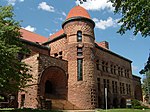Institute for Advanced Study at University of Minnesota
The Institute for Advanced Study (IAS), located in Minneapolis, Minnesota, is one of seven University-wide centers at the University of Minnesota. According to its mission statement, the IAS "supports innovative research and creative activity across disciplines, facilitates collaboration, fosters critical engagement with issues and ideas, and builds generative relationships between the University and the larger communities locally and globally." It accomplishes this mission by providing fellowships and administrative support that encourage interdisciplinary and collaborative research and creative work across the University and beyond. The Institute is a member of the Consortium of Humanities Centers and Institutes and Humanities Without Walls.
Excerpt from the Wikipedia article Institute for Advanced Study at University of Minnesota (License: CC BY-SA 3.0, Authors).Institute for Advanced Study at University of Minnesota
Southeast Church Street, Minneapolis
Geographical coordinates (GPS) Address Nearby Places Show on map
Geographical coordinates (GPS)
| Latitude | Longitude |
|---|---|
| N 44.976388888889 ° | E -93.235277777778 ° |
Address
Northrop Memorial Auditorium
Southeast Church Street 84
55455 Minneapolis
Minnesota, United States
Open on Google Maps








